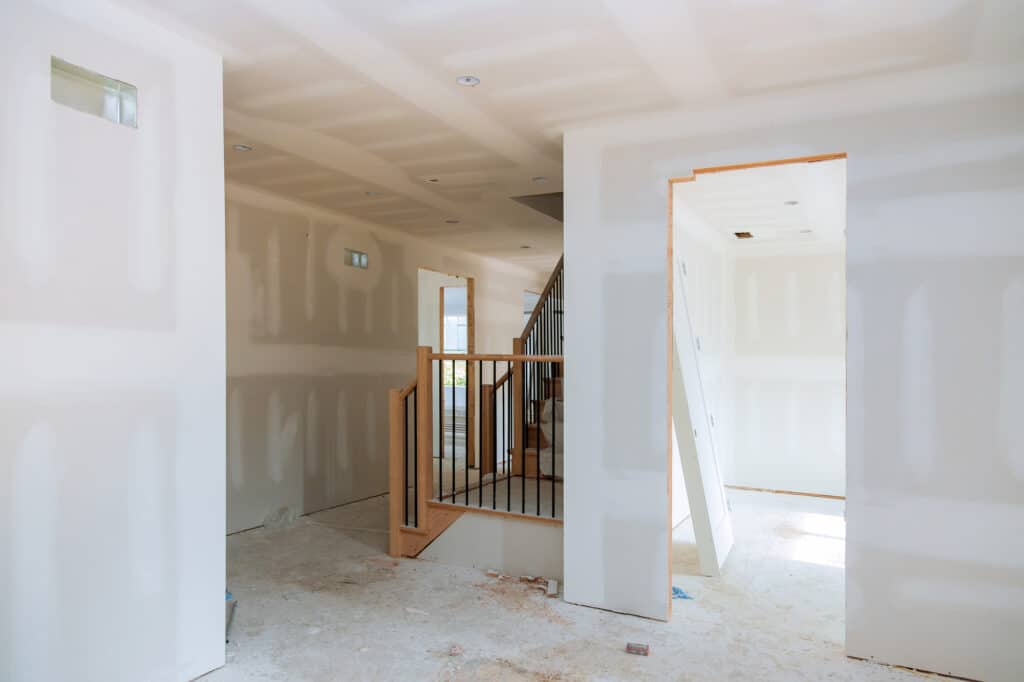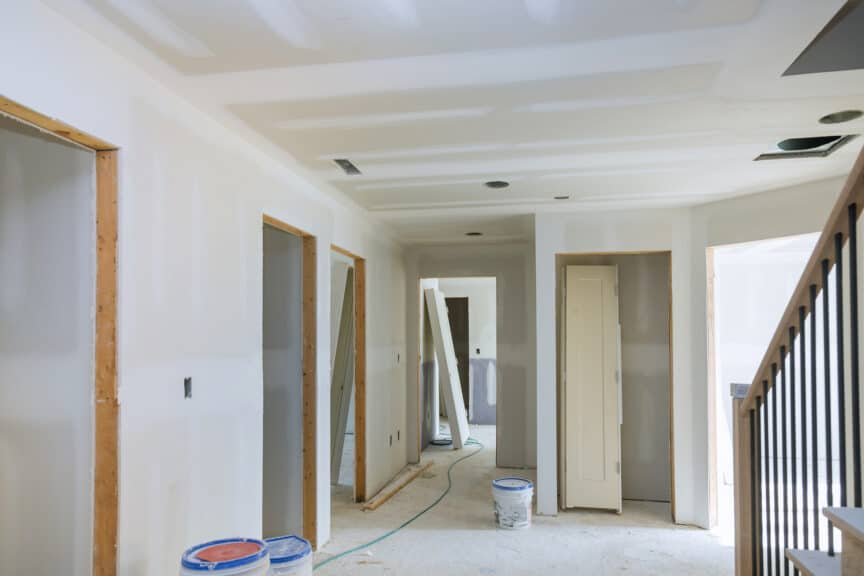Giovanni Valle is a licensed architect and LEED-accredited professional and is certified by the National Council of Architectural Registration Boards (NCARB). He is the author and managing editor of various digital publications, including BuilderSpace, Your Own Architect, and Interiors Place.
Drywall is essential to most buildings for structural support, insulation, and fire resistance. However, it can make a home look smaller after framing and insulating the building.
After adding drywall, your home interior looks smaller because it adds half an inch (1.27 cm) to every wall. Improving the lighting throughout your home, painting the walls and ceiling light colors, strategically placing furniture, and adding skylights can all make the interior appear bigger.
In this post, I’ll show you why drywall makes your home look smaller, how to prevent this, and whether drywall affects your home’s square footage.
Why Does Drywall Make Your Home Look Smaller?
If your home looks smaller after adding drywall sheets, it’s likely because you used thick drywall or possibly the sheets are bulging. It also takes a while to get used to the look of closed rooms after only seeing the frame for so long (if you’re building a new house).
Here’s a list of reasons drywall makes a home look smaller:
- Drywall adds a thin material layer, instantly making the walls slightly bulkier. While drywall rarely goes over ¾” (1.9 cm) thick, it’s more than enough to make a building look slightly smaller. Adding ¾” (1.9 cm) on all four walls in a building reduces the width and length by 1.5” (3.8 cm).
- You no longer notice reference points after installing drywall. This issue only applies to new homes, especially if you saw the framework and foundation before the drywall was installed. You might see other rooms through the drywall, not to mention everything behind the studs, which can get to 6 inches (15 cm) or more.
- Short sections of drywall add thickness to the walls. Al’s Taping Tools recommends using the longest drywall sheets to minimize additional thickness. Using many short drywall sheets means there’ll be far too many joints. Over time, the edges of each sheet point outward, making the walls look thicker and the room look smaller.
- Bulging drywall sheets make the room look smaller. This only happens if you installed the drywall incorrectly. It’s very common when people install too much insulation. The insulation pushes the drywall, loosening the nails and pushing the walls inward toward the center of the room.
Does Drywall Affect Your Home’s Square Footage?
Drywall on a new house doesn’t affect your home’s square footage because it’s part of the walls. While drywall adds between ½” to ¾” (1.27-1.9 cm) to every wall, this is accounted for in the wall thickness (similar to studs and other parts that create the initial square footage).
However, adding new drywall sheets or multiple layers of drywall can affect the square footage.
According to Bank Rate, a home’s square footage is determined after installing the walls, insulation, foundation, and drywalls. While your home might feel smaller after adding drywall, its square footage and value will be the same. If you change the thickness of your drywall, you might have to re-measure the dimensions.
Changing the drywall might seem like it shouldn’t affect the home’s interior measurements, but it absolutely does. For example, adding ⅜ of an inch (0.95 cm) to each wall reduces the length and width by ⅜” (0.95 cm) on each measurement. This means the length and width will be ¾” (1.9 cm) shorter.
The difference might seem negligible, but it’s worth considering if you’re buying a new house or selling yours. Adding thicker drywall to every room in the house could shave several square feet off the listing number, which must be updated.
So, how can you keep this from happening?
- When replacing the drywall, stick to your home’s existing dimensions.
- Add a room expansion to accommodate the reduced square footage.
- Check each stud to ensure its level before adding new drywall to any room.
Remember that a home’s square footage is the length and width, so changing the ceilings and floors won’t affect it. Instead, these alterations will change the home’s cubic footage, which is rarely part of a home listing.

How To Prevent Drywall From Making a Home Look Small
To prevent drywall from making a home look small, only use ½” (1.27 cm) sheets and consider skylights to give the impression of larger rooms. You can also reposition the furniture to free up some space.
Try these suggestions if drywall is making your home look small:
- Trim your drywall sheets to sit flush with the studs. If the sheets are curved or the studs are warped, your drywall will push toward the middle of the room. Never use bowed drywall sheets. Nail them to the studs, but don’t hammer them after the nail head is flush with each portion of drywall.
- Choose multiple color tones in each room. You can instantly change the look and feel of a room by choosing light colors on all four walls, then painting the ceiling a different shade of a similar color. For example, you can paint all walls beige and the ceiling eggshell white.
- Use skylights in big rooms to make them look brighter and bigger. Brighter colors and sunlight have long been used to bring the outside in. Not only does it make the room feel livelier, but it also makes it look wider and longer. If you don’t have skylights, open all the doors and windows.
- Make sure your insulation is tucked between the studs rather than over them. A small insulation strip between the stud and the drywall can make the room look smaller. Always check the insulation, studs, and drywall if you’re having problems with a room suddenly feeling smaller.
Final Thoughts
While drywall often makes a framed house look smaller, you can use lighting, furniture, and many other techniques to make your home look normal again. Stick to ½” (1.27 cm) drywall, and make sure you don’t overextend the drywall sheets or make them bulge with thick insulation foam or boards.
Sources
- Angi: 7 Ways to Make a Small Home Look Bigger
- Al’s Taping Tools: 5 common drywall installation mistakes and how to avoid them
- Bank Rate: How to calculate the square footage of a home (and why it’s important)
Share this Post

